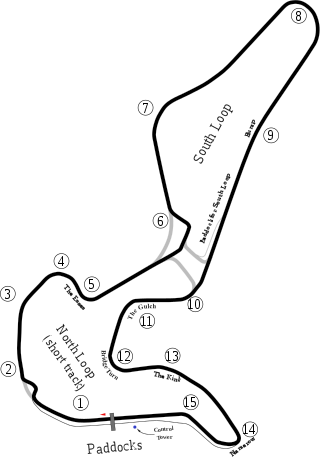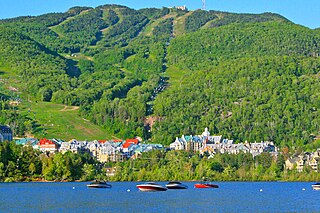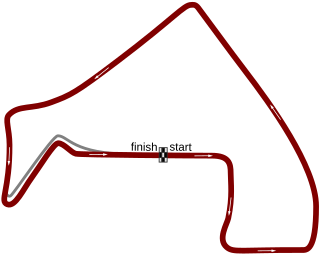
Circuit Mont-Tremblant is a 4.26 km race circuit located approximately 130 km north of Montreal, Quebec, Canada. It is the second-oldest existing race track in Canada, and was originally known as Circuit Mont-Tremblant-St-Jovite until it was renamed in the 1970s. Set in the shadow of the Mont-Tremblant ski hill, the twisting fifteen-corner track uses the natural topography and elevation of the land.

Mont-Tremblant International Airport is a single runway airport located in the township of La Macaza, 2.5 nautical miles north of the village, about 25 nautical miles north of Mont-Tremblant, Quebec, Canada.

Mont-Tremblant is a city in the Laurentian Mountains of Quebec, Canada, approximately 130 kilometres (81 mi) northwest of Montreal and 140 kilometres (87 mi) northeast of Ottawa, Ontario. The current municipality with city status was formed in 2000. Mont-Tremblant is most famous for its ski resort, the Mont-Tremblant Ski Resort, which is seven kilometres from the village proper, at the foot of a mountain called Mont Tremblant.
Claude Bourbonnais, is a former driver in the Toyota Atlantic, Indy Lights, and CART Championship Car series. He raced in the 1994 CART series with 5 starts. He also raced in the 1997 Indianapolis 500, which by then had become part of the Indy Racing League, completing 9 laps and finishing in 30th position.
Tom Klausler, is a retired American race car driver. He competed in the CART Championship Car series and in SCCA's Can-Am series.

The Circuit Trois-Rivières is a street circuit in Trois-Rivières, Quebec, Canada. The circuit has been the home of the annual Grand Prix de Trois-Rivières, the longest-running street race in North America, since 1967. The circuit is located on the Terrain de l'Exposition (fairgrounds) and is unusual in that it passes through Porte Duplessis, the narrow concrete gateway of the grounds at turn 3.
The 2002 Grand American Road Racing Championship was the third season of the Rolex Sports Car Series run by the Grand American Road Racing Association. The season involved five classes: Sports Racing Prototype I and II, Grand Touring Sport (GTS), Grand Touring (GT), and American GT (AGT). 10 races were run from February 2, 2002 to November 10, 2002. Mont-Tremblant replaced Trois-Rivières. California Speedway replaced Lime Rock. Virginia International replaced Road America. The season also was marred by the death of Jeff Clinton during the Nextel 250 race weekend.

The Mont-Tremblant Champ Car Grand Prix was an auto race in the Champ Car World Series. It was held from 1967 to 1968 and again in 2007. It was held at Circuit Mont-Tremblant, in Mont-Tremblant, Quebec, Canada.
The 2008 Atlantic Championship season was the thirty-fifth Atlantic Championship season. It began on April 20, 2008 and ended on October 4, 2008. Despite the merger of Champ Car's premier series with the Indy Racing League, the Champ Car owners continued to own and operate the Atlantic Championship under a new legal entity, Atlantic Racing Series, LLC. Champ Car continued to sanction the first two events of the season at Long Beach and Laguna Seca with the remainder of the season running under IMSA sanction. The Cooper Tires Presents the Atlantic Championship Powered by Mazda Drivers' Champion was Markus Niemelä driving for Brooks Associates Racing.
The 1968 Trans-American Championship was the third running of the Sports Car Club of America's Trans-Am Series. 1968 marked the addition of the 12 Hours of Sebring and the 24 Hours of Daytona, the only year that the Trans-Am Series featured those races. The season also marked the first time that an event was held outside of the United States, when a race at Mont-Tremblant brought Trans-Am into Quebec, Canada.
The 1977 Can Am season was the tenth running of the Sports Car Club of America's prototype-based series. Despite the revived name, however, the new series was entirely unrelated to the previous series which had folded in 1974. Most of the competitive cars were based on Formula 5000 chassis. Also, the first time under 2-litre cars were allowed to race, but with no separate class. Patrick Tambay was declared champion, winning six of the nine races that year for Carl Haas. While Lola chassis dominated the series, a Chevrolet powered Schkee DB1 driven by Tom Klausler won the first race at Mont Tremblant. Other competitive cars included the 1974 champions Shadow, who now used Dodge engines and Wolf with a Dallara-built chassis. While Chevrolet was not the only engine supplier, they swept the entire season. This season also marked a resurgence of interest in SCCA events, with Can Am accompanying F5000 and the Trans Am Series seeing a mild resurgence in the eighties.
The 1979 Can-Am season was the twelfth running of the Sports Car Club of America's prototype-based series and the third running of the revived series. Formula One legend Jacky Ickx was declared champion, winning five of the ten rounds and finishing second at Road Atlanta. Chevrolet again dominated the season. The top chassis builders were Lola, Prophet, and Spyder, with Vern Schuppan finishing third at Watkins Glen in an Elfin and Al Holbert finishing third at Road America in a Hogan.
The 1980 Can Am Series season was the thirteenth running of the Sports Car Club of America's prototype based series and the fourth running of the revived series. Patrick Tambay was declared champion, winning six of the ten rounds and finishing third at Riverside. Chevrolet again swept the season. Lola, Holbert, and Prophet were the dominant chassis suppliers, with Intrepid finishing second at Watkins Glen and Frisbee finishing first at Laguna Seca.
The 1983 Can Am season was the sixteenth running of the Sports Car Club of America's prototype series and the seventh of the revived series. 1983 marked the second year of Chevrolet having major competition, with Cosworth taking second at Mosport, first at Lime Rock, second at Trois-Rivières, first at the second race at Mosport, and second at Sears Point. Hart would take third at Lime Rock and third at Trois-Rivières. Porsche would get its first podiums this season, with a win at Road America and third at the second race at Mosport. The dominant chassis were Frissbee, Ensign, Lola, VDS, Scandia, and Ralt. Jacques Villeneuve, Sr. was declared champion, with podiums in almost every race. He would, however, become the final major racecar driver to win a Can Am championship.
The 1986 Can-Am season was the nineteenth running of the Sports Car Club of Americas prototype series, and the tenth running of the revived series. The dominant manufacturers were Cosworth, BMW, and Volkswagen for the first time with a third-place finish at Summit Point. The dominant chassis were Lola, March, Oscella, Yorkshire, Frissbee-Lola, and Frissbee. After 1986, Can Am would become the Can Am Teams championship, using modified CART March 86Cs. In 1989, the name was again revived with a spec Shelby series. Horst Kroll was declared champion.

The Spyder NF-10 was an American sports prototype racing car built for the Can-Am series in 1978. It was based on a Lola T333CS, and was developed into the Spyder NF-11 in 1979. Two NF-10s were built in 1978, whilst four NF-11s were built in 1979, two of which were originally NF-10s. Both the NF-10 and NF-11 featured a 5-litre Chevrolet V8 engine.
The Frissbee KR3 was an American sports prototype racing car, built by Frissbee in 1984 for the Can-Am series. Originally built by Lola Cars as a Lola T330, it featured a 5-litre Chevrolet V8 engine, and was used by Horst Kroll Racing between 1984 and 1987. Horst Kroll used the car to win both the Can-Am and Canadian American Thundercars Championship in 1986.
The March 817 was a British sports prototype racing car, built by March Engineering in 1981 for the Can-Am series. As with all other full-size Can-Am cars of the time, it used a mid-mounted 5-litre, naturally-aspirated Chevrolet V8 engine. Two cars are known to have been built. Paul Newman Racing won the Team's championship of the Can-Am series in 1981 with the March 817, whilst their main driver, Teo Fabi took second in the driver's standings.
Ken Duclos is a Americas former racing driver. Duclos competed in the Trans-Am Series, Atlantic Championship among other series.

Marc-Antoine Camirand is a Canadian racing driver. He currently competes in the NASCAR Pinty's Series and is the 2022 NASCAR Pinty's Series champion.





